#anamorphic lens
Text



Досліджуємо анаморфоти крізь призму Сімс 3
#ukrainian filmmaking#filmmaker#filmmaking#кіновиробництво#фільммейкінг#director of photography#film photography#kyiv#kyiv ukraine#sims3#anamorphic#anamorphic lens#sims screenshots
16 notes
·
View notes
Photo


https://www.youtube.com/watch?v=KJWAgUKOB-k&t=60s
44°58'23.5"N 6°03'54.8"E
youtube/oftwolands
#bmpcc6k#anamorphic#frames#france#French alps#cinematography#filmmaking#girl#travel#alps#summer#mountains#bmpcc#anamorphic lens#Blackmagic design#mountain#landscape#outdoor#florent piovesan#of two lands
78 notes
·
View notes
Video
Mansfield Lantern Festival x Anamorphic Lens
0 notes
Video
youtube
Hasselblad Xpan on a budget
0 notes
Text
Hatsune miku🩵🎤✨


#hatsune miku#vocaloid hatsune#miku hatsune#clip studio paint#went emulating kowa anamorphic look due how distorted that lens was while it still giving lovely look
0 notes
Text
No such thing...
as a perfect lens...and unfortunately, this particular example is so far from perfect. I think it is broken and will have to go back - simply no focus anywhere in the image.

0 notes
Text
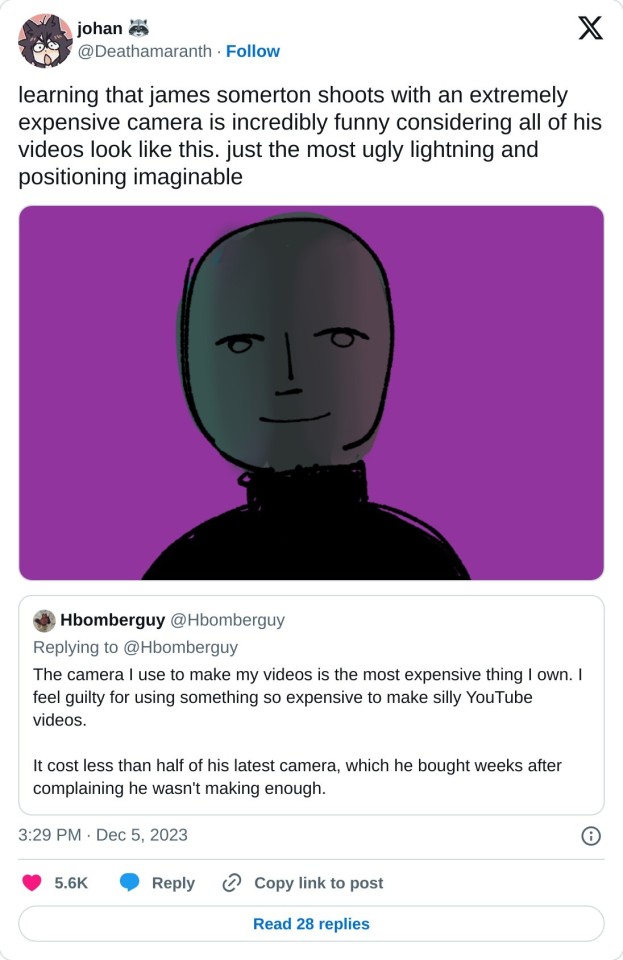
I hate that you can't see a tweet thread anymore if you're not logged into Twitter (as a gesture of disrespect I refuse to call it by its rebranded name). Here is a copypasta of a thread from Dan Olson, a Canadian documentary filmmaker, expanding upon camera quality, the guilt trips Somerton used to goose his Patreon subscriptions, and how the best tools will never make up for lack of dedication or patience. I have added clarifications in [[double brackets]] where I feel it is necessary.
START OF THREAD
Okay, so, back in April I snapped at James in reply to a tweet that was linking to this video (which James has since delisted but not deleted) and I want to talk about the full context of that but I don't want to make a video, put your beatdown memes away. [[The video has since been deleted. I can see the title of the video is "Maybe the end (not an April Fool's Day thing".]]
The first bit of context is that I initially got keyed into James to fact-check his claims about indie filmmaking in Canada. As a filmmaker the entire Telos venture was immediately obvious as a juvenile fantasy dreamed up by someone with no idea how to make a movie.
Just wild claims about their plans that weren't worth debunking because they bordered Not Even Wrong. But in watching one of these pitch videos I noticed that he had a $4000 current-gen camera in the background as a prop, and that seemed both pretentious and weird.
You don't use your best camera as a prop, you use your second best camera as a prop. So being an obsessive weirdo I needed to know, and I watched his BTS stuff until I spotted his main rig, a $6000 camera with about $1000 in accessories.
Now, these in isolation are unremarkable because his Patreon at the time was bringing in ~$8000 per month, his channel was a full on Business business, and so investing in some professional equipment of that level is maybe a bit indulgent but justifiable.
What was weird is that he doesn't shoot multi-cam, doesn't shoot outdoors, doesn't shoot on location, and in a studio the two cameras kinda really step on each others' toes. Basically if you already have one and don't need a B cam there's no reason to get the other.
Again, on its own, this says nothing, it's just indicative of poor financial decisions, maybe impulsive purchasing, Gear Acquisition Syndrome. Biblical sins, but not crimes.
Paired with the constantly inflating fantasy scope of the Telos films it was clearly an expression of a very, very common bad filmmaker habit of "if I just get the right gear then my movie will basically make itself" Buying stuff because it feels like progress.
At the end of February he tweets "I want to start shooting anamorphic" and then three weeks later in March he posts the worst, out of focus, under-exposed "I just got a new lens!" video I've ever seen, showing off his trash-covered bedroom.
Based on what's available for his cameras and the lead time, that's enough time to get a Laowa Nanomorph or Sirui Saturn from B&H but not enough time to get a Great Joy from the UK or a Vazen from China. And with the flaring blah blah blah, $1300 lens.
Again, [gear acquisition syndrome] is not a crime and these lenses are budget options. Bit of a pointless impulse purchase since he only used it for the Showgirls video. But this is what he was doing just a few weeks before that above video came out: effortlessly impulse purchasing lenses.
James has (had?) a habit of regularly, aggressively driving viewers to Patreon by claiming that videos were getting demonetized. While tacky, it is something a lot of queer YouTubers have dealt with, so there's precedent there. But people were noticing he did it a lot.
Mid-March he humble brags about needing to work so hard to make 6 videos in April because he has over-booked sponsorships.
Then March 29th James posts this whole incel screed on Twitter about how sex work should be "subsidized as a mental health service."
[two image descriptions.
1. "For the majority of people sex (and human contact) can be imperative to a healthy state of mind. A kind and talented sex worker can make someone feel wanted for the first time in their life. I know sex workers who have pulled people back from suicide just by being there for them."
2. "Not only should (sex work) be legal, but it should be subsidized as a mental health service."]
He spends several days getting absolutely *roasted* for this, just dragged across the pavement and read for filth, and doubles down in the replies the whole way.
So this is the context immediately surrounding James waking up on Friday, and posts the above video and the below tweet.
[image description: "We just got the lowest Patreon payout we've gotten in well over a year. Like, a "maybe we need to rethink things" kind of amount... NOT an April Fools Day thing btw. But I don't know if we'll be making videos much longer."]
Now, this unfolds in kinda two directions. The first is that I'm convinced he was just lying about this income shock in the first place.
There's a million theoretical edge cases about what maybe happened and if maybe he just misunderstood the data or saw a glitch and panicked, maybe one of those happened, I don't believe it, I think he just lied because he was salty about getting dragged and felt owed a win.
A big tell to me is that he doesn't blame Patreon. He says he doesn't know what happened, but let's be real, Patreon screws up all the time, they're the first people anyone blames if anything confusing happens, just as a reflex action, even if it's completely not their fault.
The only reason to not blame Patreon is if you already know that it's not their fault and that any investigation on their part might reveal embarrassing details.
Instead he indirectly blames his viewers for not watching enough, not sharing enough, and not turning on auto-renew.
So regardless of the unknowable truth, this segues into the second, far more offensive direction of the messaging itself. "I don't know if we'll be making videos much longer." "Maybe the end" He explicitly framed this as an immediate existential threat to his channel.
In the video he is vague about everything, leaves a ton of hazy room for plausible deniability on how long the channel can keep going, but the messaging is "I need more patrons right this minute or my YouTube channel is over."
He repeatedly evokes all the "fun stuff" they had planned that would never see the light of day if this didn't turn around right away.
And his audience received this message loud and clear. Tons of people making far, far, far less than him left very heartfelt messages about digging a little deeper to subscribe or up their pledge or unsubscribe from other channels to move their pledge to his.
1200 new patrons in one day.
Since I simply don't believe the income shock was real in the first place that would put his post-"Maybe the end" Patreon income at around $10,000 per month. US. Add YouTube income, he's spent the last seven months making around $18,000 per month.
I have seen creators scale back their capabilities to the bone purely to keep making videos for the love of just, like, making stuff even as their funding evaporated and they needed to go back to a desk job to cover their bills.
You'd have to be so outstandingly reckless with your finances as a channel that a one month spook leads immediately to "channel over, sorry about all the fun stuff we won't get to do with you, our patrons, specifically because you, our patrons, aren't giving us enough money"
And not a spook where you then spend a couple weeks crunching numbers. Oh no. A shock so violent where less than two hours later you're weeping on camera about the channel being over.
Three weeks later he brought a brand new Sony FX6v for $8000 CAD to add to his pile of cinema cameras despite the fact that he was, but scant moments earlier, in such a precarious position that a single bad month would kill his channel.
He stole your money, and for that I'm profoundly sad and angry. That's why I snapped at him in April. I'm sorry I couldn't give you the full context then, and I'm sorry if that anger upset you.
END OF THREAD
#james somerton#dan olson#hbomberguy#jesus christ tumblr#it won't let me format things the way i want#because this website is sometimes a piece of shit
6K notes
·
View notes
Text
Take Kayo of Big Head Taco Is Experimenting with Sirui Anamorphic Lenses for Panoramic Stills Photography: Is It The Best Solution for Panaromas?
Take Kayo of Big Head Taco Is Experimenting with Sirui Anamorphic Lenses for Panoramic Stills Photography: Is It The Best Solution for Panaromas?

View On WordPress
#Fujifilm G617 Professional 17-6cm 120 roll-film panorama camera.#Sirui 24mm f/2.8 1.33x Anamorphic Lens#Sirui 35mm f/1.8 1.33x Anamorphic Lens#Sirui 50mm f/1.8 1.33x Anamorphic Lens
0 notes
Text

Part 1 of looking into some of the technical cinematography aspects of the show
(or, why does Dead Boy Detectives look Like That?)
(update 6/30/24: there's now a part 2! check it out here)
Dead Boy Detectives has some interesting things going on with the cameras. You probably noticed it at some point while watching the show. Whether it was the weird blurs or the sort-of-fisheye, there’s something about many of the shots that doesn’t look the way many people expect TV shows to look. ��
The main reason why is because it uses an anamorphic lens instead of a spherical lens. These lenses are pretty different from spherical lenses, and the recent rise of anamorphic lenses in TV has not been without some pushback, as viewers unaccustomed to them may find the look weird, distorted, or that it pulls their focus away from the content. Whether you enjoy how Dead Boy Detectives looks or find the cinematography distracting, this post is designed to explain the different effects that the lens has on the show.
This post is very long and very graphics heavy (I made lots of gifs to illustrate my points) so the rest is under a read more.
What is an anamorphic lens and what is it used for?
To begin with, a bit of history and technical info. Say you’re making a movie at most any point before the mid-'90s and you want it to be widescreen. However, the 35mm film you’re shooting on has a smaller aspect ratio (closer to a square than widescreen). You could use letterboxing (black bars on top and bottom) but then you waste the top and bottom parts of the film, and it ends up being slightly lower in ‘resolution.’ The solution: use a lens that records the full height onto the film, but squishes the picture horizontally so that it fills up the whole film frame without any letterboxing. Then, a projector (or a computer) can stretch it out again to display the whole thing in widescreen. The kind of lens that can do that is an anamorphic lens. They've technically been around since before the 1920s but were mostly used between the 1950s and the 1990s.
Up until sort of recently, television networks broadcasted using a smaller aspect ratio that they required shows to be in, and TV shows were not given the kind of cinematography budgets that movies were afforded. Anamorphic lenses are expensive and for widescreen, so they really just weren’t used for TV shows. Instead, a spherical lens was used, which is just the standard lens you think of when you picture a camera lens.
In the 90s, new flat/spherical film formats came out that allowed for widescreen (one of the popular ones being Super 35) caused anamorphic lenses to drastically drop in popularity. However, there has been a recent resurgence, one that you’ve probably subconsciously noticed in both film and television.
In the last 10-15 years, TV has been given larger and larger budgets. Additionally, the rise of streaming services and the use of phones and computers to watch shows rather than actual televisions has meant that networks have started allowing wider aspect ratios, paving the way for anamorphic lenses to begin to be used for series.
The history of these lens’ usage means they’re associated with a ‘cinematic’ look. They have a lot of characteristic effects that are not really ‘natural’ and depending on the viewer, this either enhances the experience or detracts from it.
Lots of recent series have been embracing these lenses (to varying degrees of success), including The Witcher, Sandman, Shōgun, Narcos: Mexico, The Mandalorian, Andor and Chilling Adventures of Sabrina. Doctor Who also started using anamorphic lenses at the switch to the 13th Doctor, so that may be a good reference point. For some of these, it’s a very subtle look, for others, the lens choice is glaringly obvious and overdone (I’m looking at you Sabrina), and sometimes, as is the case with Dead Boy Detectives, it’s really obvious but it remains an effective and compelling choice.
Why use an anamorphic lens in the 21st century when you could just use a spherical lens?
Anamorphic lenses create a look that some filmmakers desire, whether for their associations with a more cinematic look or their sometimes unusual quirks. In a film and tv world filled with spherical lenses that are nice, clean, and precise, anamorphic lenses introduce some irregularity and character. Making an informed decision on what kind of lens to use can enhance different themes of the work.
I want to briefly bring up Moonlight to illustrate this point. Go watch the trailer if you haven’t seen it, and you’ll probably see some parallels with the cinematography of Dead Boy Detectives. There’s less of the ‘radial’ look, but otherwise, there’s a lot of the same kinds of things. Moonlight uses an anamorphic lens and it makes the whole thing look dream-like, nostalgic, and a bit like we’re getting into the character’s heads. To me, it indicates that the story is being filtered through people. We’re not detached from the characters, observing them. The story we are watching is personal, emotional, and necessitates intimacy.
Dead Boy Detectives really benefits from the same visual effects. This is not because it enhances a dream-like or nostalgic quality, but because in the context of the show, it makes it look a bit otherworldly, magical, or otherwise supernatural. Additionally, the constraints of the lens means we get lots of focusing in on individual characters, with nice long looks at their faces allowing for more reflection on their dialogue and reactions.
So, here’s 5 different effects of anamorphic lenses to point out to you all. Starting with the one that allows us to easily identify that anamorphic lenses are being used in the first place.
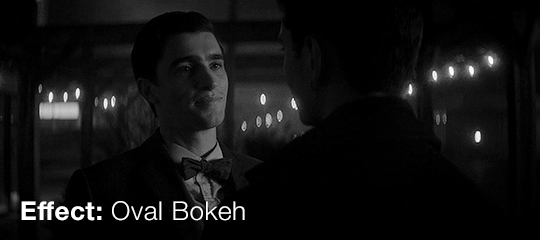
You’ve probably heard of bokeh before. It's the way the lens renders the direct sources of light that are in the background but out-of-focus. You can see in this shot of Jenny how all the string lights are not circular, but elongated. On a spherical lens, these would be round.
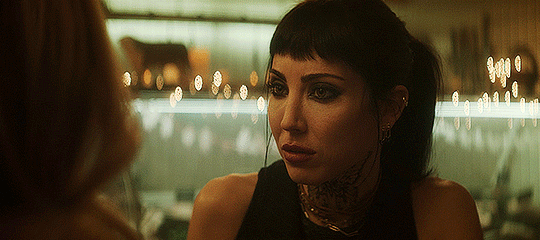
In this next shot of the Cat King, the candles around the floor are all those elliptical shapes. Additionally, lots of other details in the background that aren’t from direct light sources also have an elongated shape. This is sometimes called waterfall bokeh.

Finally, check out this shot of one of the cats. Not only are the lights in the background irregular and elongated, but if you look to the left where the ‘horizon’ line is, there's a series of elliptical shapes where the light hits the edge of the docks.
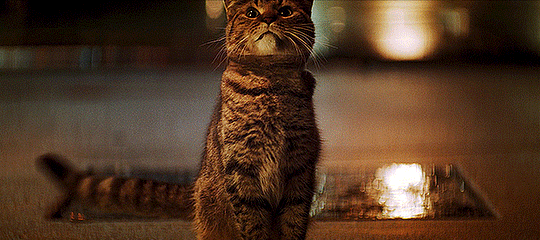
The bokeh effect is one of those things that just happens because of the lens, and makes it pretty easy to identify that an anamorphic lens is being used. Unlike some of the other effects I’ll mention, I don’t have much to say about how this does or doesn’t add to the visuals.

Breathing is how the field of view changes when you refocus to a subject closer or farther from the lens. While spherical lenses also breathe, there’s a much more distorted look to the breathing that occurs with an anamorphic lens.
Lets start with this shot:
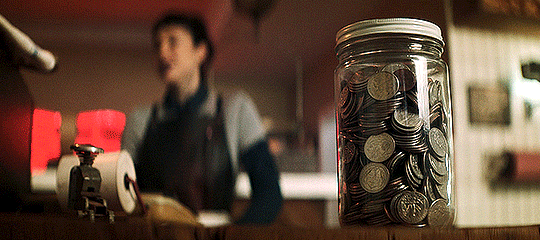
You can see how much the frame widens when the focus shifts from the jar of coins to Jenny. It affects the edges much more than the middle of the frame. Here’s the same shot, but with some of the features outlined (forgive my messy outlining, I used my laptop trackpad) so you can see the movement.
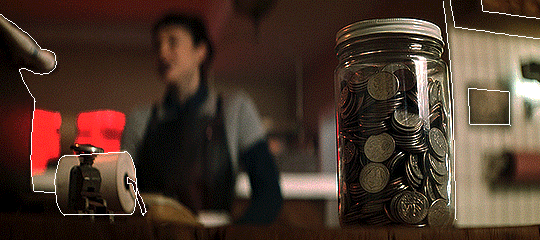
The frame widens when the focus goes from the foreground to the background. It appears like the whole shot is being stretched apart horizontally and compressed vertically.

However, it also does the reverse, narrowing as the focus moves from the background to the foreground.
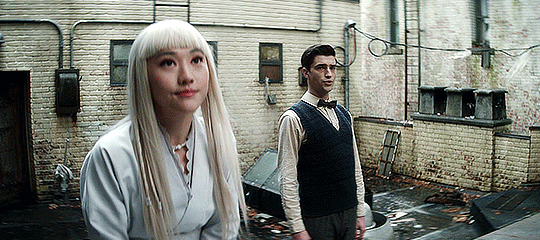

(also in that last shot of hell, notice how the two points of light in the background elongate into those oval bokeh once they are no longer in focus)
Breathing is a very dramatic way of refocusing, and it forces us to pay attention to different things. In the shot of the Night Nurse, we have a light but the important thing after it turns on is not the light but the reaction that the people have to the cause of the light. In that shot of Niko and Edwin, it’s telling us: listen to Niko. In the shot of hell, it’s not letting us forget what the characters are running from.
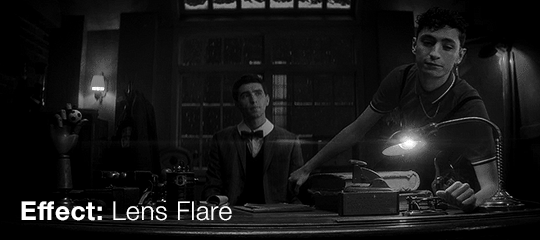
The next effect is the lens flare. You can get a lens flare from a spherical lens too, but anamorphic lenses typically generate strong, horizontal flares. A spherical lens would typically create a more radial flare, with multiple lines shooting out in different directions from the light source like rays from the sun.
We see these all over the show, sometimes they’re very prominent, such as in these shots with obvious light sources:
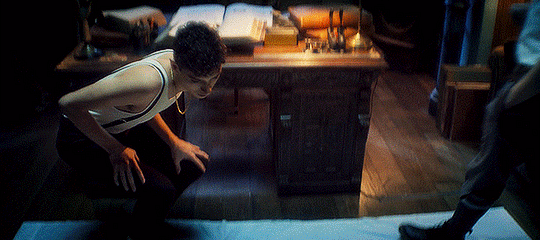
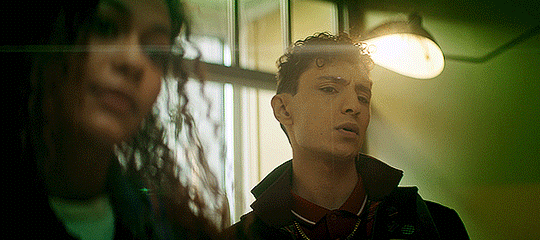
And sometimes they're a bit more subtle. Take this shot of Edwin, Charles, and Crystal on the dock:
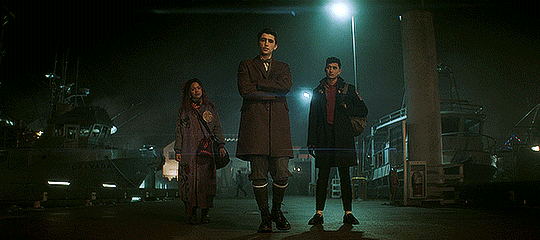
While the lens flare at the top of the frame has a clear source, there’s a bunch of other horizontal lines cutting across near the middle and bottom half of the frame. These likely come from light sources outside of the frame.
Some directors, cinematographers, and other creators really like anamorphic flares. Others don’t. For a show with so many dark scenes that have colorful and dramatic lighting, the lens flares seem to enhance this. They are also a constant reminder of the interaction between the lights and the camera, kind of a fingerprint of the production. Sure, they make it seem more ‘cinematic,’ but I think they also ground us in the physicality of the production. (Kind of ironic given the lack of physicality of the main characters, and also you could consider the flares themselves to be the ghosts of the lights and the camera!)

Barrel distortion is where we start getting into why exactly the show looks the way it does. This is basically a subtle fisheye effect. Because of the squishing and stretching of the footage, anamorphic lenses have more distortion than spherical lenses, and it is strongest around the edges.
You can see it most clearly in shots that have lots of vertical lines. They are relatively straight in the middle of the frame, but the closer to the edges, the more they are warped.
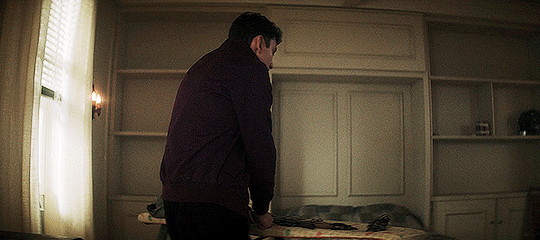
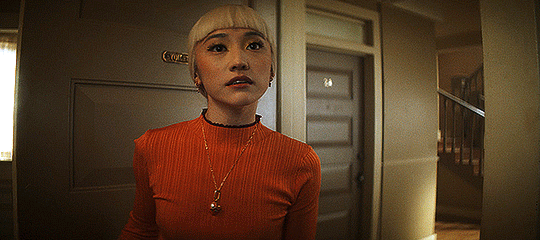
Looking at that shame shot of Niko in the bathroom, I have set it to stop at 3 different spots. Pay attention to the shape of the edge of the door.
At the start, it’s curved outward, like an open parentheses: (
Then, in the middle, it’s a vertical line: |
Finally, as the door passes all the way across the frame to the opposite side, it curves inward, like a closed parentheses: )
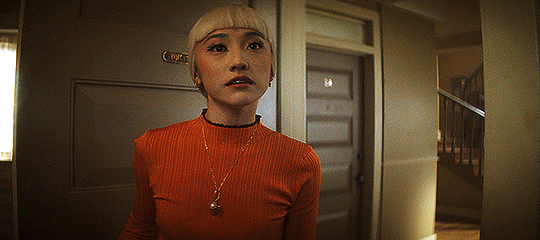
Again, notice how the lines in this shot of the Lost & Found Department change as they move from the outside towards the center. The door has an outward bulge at the beginning but becomes more 'normal’ shaped as it gets further away.

Anamorphic lenses can also have a pretty shallow depth of field and it’s used a lot in this show which is why we get a lot of those centered close-ups, and why we get that ‘radial blur.’
The center of the frame is where the actors are least likely to be distorted, meaning its easiest to have just one character in the dead center (pun intended). With a shallow depth of field, the background is out of focus, and since the actor is in the center, the background gets the most affected by the barrel distortion, leading to the sense that the background has been radially blurred.
This blurred background with a strong, centered foreground really makes objects in the foreground pop. We are then able to really focus in on different objects and characters. It brings immediacy and intimacy. Here, we have nothing to do but consider Charles. He isn’t speaking so we must consider his reaction to what’s being said.

Also, the further a character is from the center of a shot, the more they are distorted, such as Edwin and Charles in this still:

This kind of distortion definitely lends a more unnatural look to the shots, which definitely supports a show about ghosts and the supernatural. If the subjects are able to see things in our world in a way the viewers cannot, then why display the physical world the way we see it?

Finally, we have focus falloff. This is (like some of the other effects) a distortion that occurs around the edges. Here, the focus decreases the further from the center of the frame even if they’re all about the same distance from the camera.
In this shot of the Tongue & Tail, the sign 'Butcher Shop’ is clear and legible. But imagine if that sign was up in the top left or right corners, where things start to get blurry. We probably wouldn’t be able to read it.
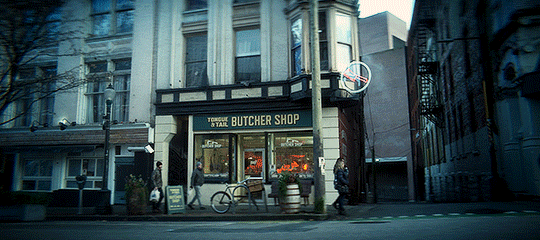
It's also visible in this shot of Edwin. Not only does the floor get blurrier the further you get from the center, but you can see how the rope is less in focus in very top and very bottom of the frame.
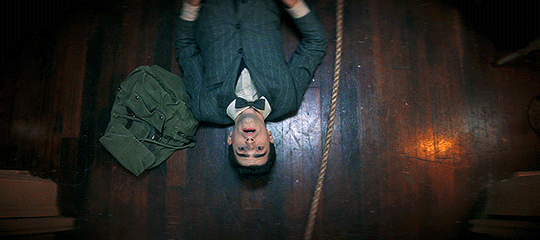
The falloff (combined with the barrel distortion) is how we get the really unique dream-like look of the Edwin and Niko scene on the roof in Episode 8. (If you’re having a hard time spotting the falloff here, look at their legs)
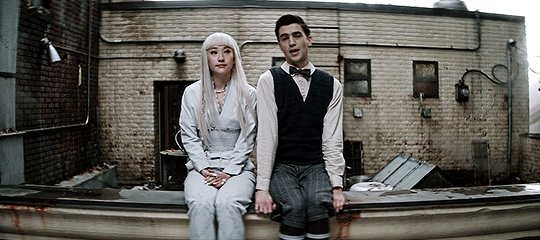
When you start looking for falloff in this show, you start to see it everywhere. It’s easiest to spot in the corners of shots, but you can usually see all the way around the edges.
Look at the corners of this still of Edwin, or the way the top and bottom of Niko’s rent envelope aren’t as clear as the middle of it.
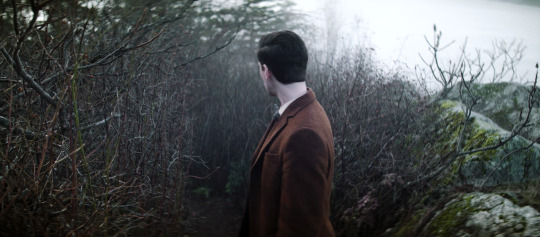
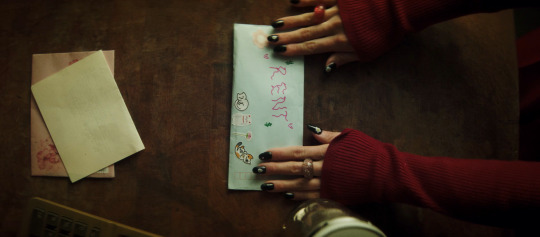
Or in this still, look at Charles’ jacket. The arm closest to the center has a much more defined line between it and the background compared to the arm closest to the edge.

This blur definitely is one of the more noticeable effects in the show, and it’s good at focusing our attention on the center of the frame. It guides the viewer exactly to what we should be looking at. We get tons of centered shots in this show because of this and the barrel distortion.
The falloff makes the show look softer and artistic, sometimes painterly or impressionistic. More than any other effect, the falloff is what makes me feel like I’m watching a dream or a vision. It puts us into the sensation of being fully immersed in a story.
I would argue that all of these effects (but especially the last two) not only enhace the supernatural aspect of the show, but they help us fall in love with the characters. They focus us on their faces, and encourage us to reflect on their motivations, reactions, and thoughts. The lens is telling us that we are not to take things at face value. It’s not letting us forget that there are multiple people and multiple stories involved, that things are blurry around the edges, and that things are not perfect and clean-cut.
-----------
Sometime in the next week or so I’ll be working on part 2, where we’ll take a closer look at the cinematography of Edwin’s flashback to 1916 in Episode 1. It's posted! Read it here.
I really wanted to highlight the work of the cinematographers, Marc Laliberté, Craig Powell, and Pierre Gill because it’s clear that there was so much care and intention put into every aspect of this show.
I’m so glad fans of this show are really embracing the work of different crew members, like the work of costume designer Kelli Dunsmore (and if you somehow haven’t seen @captainfantasticalright's posts about the costumes and other aspects of the show, please go check them out right now. My roommates and I have a kind of 'stop everything, new costume analysis dropped' attitude towards their posts, and their approach to show analysis was definiteily an inspiration for this)
If you want to read more about anamorphic lenses, the article Why ‘Shogun’ (and the Rest of TV) Is Slightly Out of Focus in The Ringer is about Shōgun and the rise of anamorphic lenses in TV (Marc Laliberté also worked on a few episodes of Shōgun) and it's a great place to start.
Finally, I want to first thank @skyvoice for these tags on one of my gifsets for semi-inspiring this post (I was already considering making this but these made it into a reality).
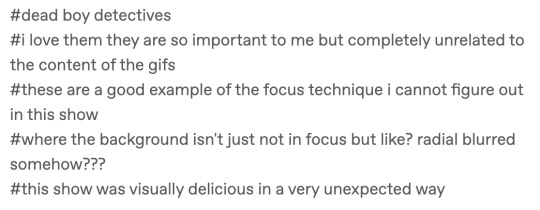
#dead boy detectives#charles rowland#edwin payne#niko sasaki#crystal palace#cinematography#cinematography analysis#dbda#mygifs#dbda meta#dead boy detectives analysis#dbdagifs
349 notes
·
View notes
Text
youtube
44°58'23.5"N 6°03'54.8"E
youtube/oftwolands
www.oftwolands.com
#of two lands#anamorphic#bmcc6k#Blackmagic#Blackmagic Design#cinema camera 6k#france#girl#golden hour#sunset#light#6:5#anamorphic lens#6k#people#family#forest#color grading#filmmaking#cinematographer#cinematography#filmmaker#mother#mum#glow#great joy lens#BLAZAR Lens#lens#camera#gear
10 notes
·
View notes
Video
Mt Buller murky foggy night clips x Anamorphic Lens
0 notes
Text
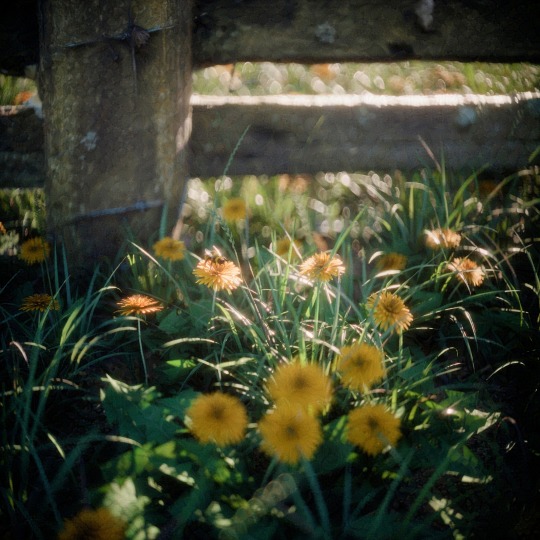
First post. Created this Tumblr a while ago but have had a bout of art block for a long time. Hopefully coming to an end.
I made this while testing a 3D grass asset product for someone. The main goal here was to achieve a photoreal look for the lens and a high quality film emulation including halation and real Kodak Portra 400 film grain. I did decide to go with anamorphic bokeh for fun.
———
Rendered in Blender 4.1
My work uses Assets from Artum
———
Credits
———
Rosedale Railway Fence - 3D Model - Land of Iron on Sketchfab
Bee - 3D Model - The Vaudeville Horror Show on Sketchfab
Provided under License: CC Attribution
https://creativecommons.org/licenses/by/4.0/
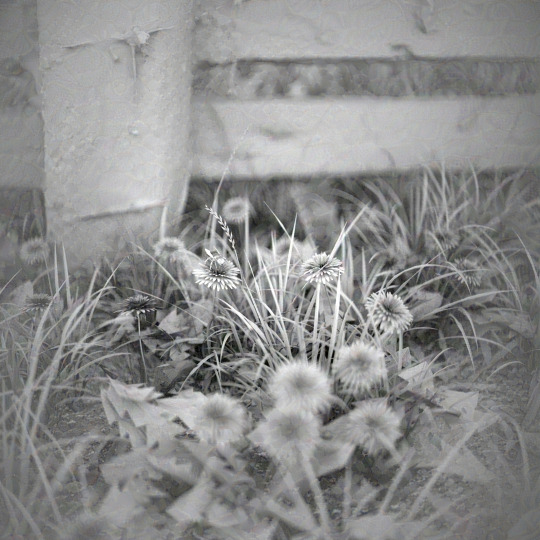
4 notes
·
View notes
Text
Bloody

A Man with a Sword Standing in the Snow, society 4k”, Urban Samurai, The Glow of the Moonlight, Sasuke 5 0 0 pxL models, Lobo, arcane from Netflix, style of Kanagawa, Tomas Kinkade, anamorphic lens flares, by Emerson Silva, Miyamoto Musashi, cyberpunk 2077”, manga art, streaming on twitch
6 notes
·
View notes
Text
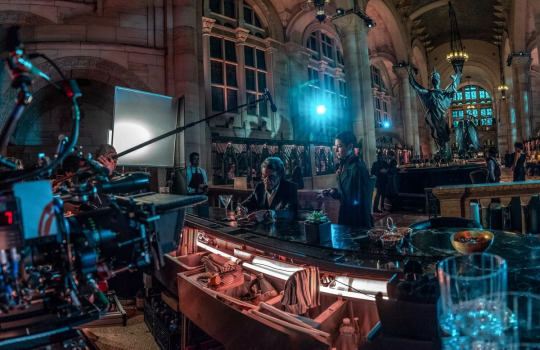
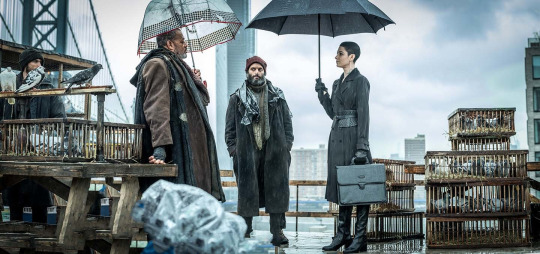

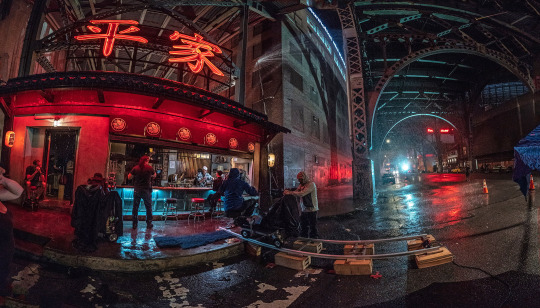
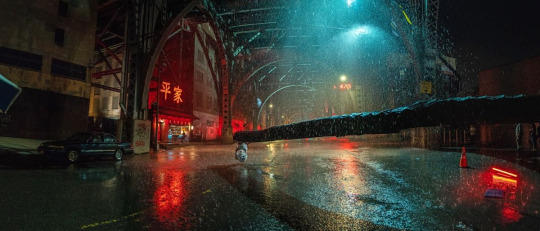
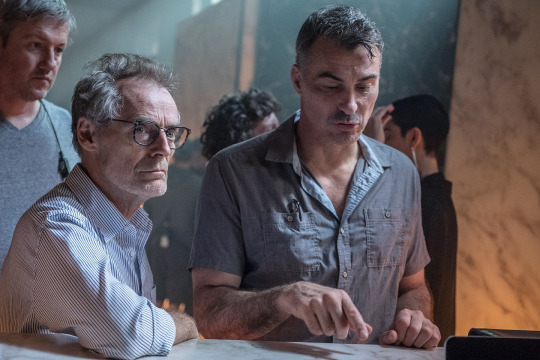
behind the scenes shots ft. akd as the adjudicator, from this article about the cinematography
“In Hollywood, action filmmaking was kind of looked down upon until The Matrix, and then people realized that action could also be part of the story,” [director] Stahelski notes. “I come from a place of loving dance and theater and fine art — action can be all of those things — and one of my favorite painters is Caravaggio.” When he was looking for a cinematographer for John Wick: Chapter 2, Stahelski recalls, “I asked myself, ‘Who paints with light?’ The answer is Dan Laustsen.”
In strictly cinematographic terms, Parabellum functions less like an action movie and more like a Hollywood studio musical. The film’s first battle is a close-quarters knife fight in an antique weapons shop, where the camera cuts from wide shot to wide shot, sustaining the action in long takes so that the audience can better appreciate the physical prowess of Reeves’ performance — an elaborate fighting style that combines Japanese judo and jujitsu, Brazilian jujitsu, Russian sambo, Filipino kali, and Muay Thai, more for the benefit of show than for self-defense.
“Ninety-nine percent of high-level stunt work is dance — not pirouettes, but how you move your body,” asserts Stahelski, who continues to train stuntpeople with Leitch through their company 87eleven. “I love the aesthetic of motion. A lot of our shots [in Parabellum] are lifted straight from Singin’ in the Rain and West Side Story. We’re mixing Buster Keaton and Charlie Chaplin with Hong Kong cinema from John Woo, Jackie Chan and the Shaw Brothers.”
“We wanted to go wider than Hollywood action films normally do and really show off the choreography,” Laustsen agrees. “When the camera, lighting and actors are all moving together, it really is a dance.”
“After we made Chapter 2,” Laustsen notes, “we discussed how we could make 3 even more visually powerful. The main setting was still New York, but we wanted to bring out the city even more forcefully. We decided to shoot all at night, with rain as much as possible. Rain is fantastic because it gives a third dimension to the picture, but it is a challenge to do it, especially in a city like New York.”
The Master Anamorphics’ low-distortion design also prevents dramatic, streaking lens flares, and so the technicians at Arri Rental in Secaucus, N.J., fashioned a flare filter — comprising three strands of nylon fishing line stretched across an empty filter frame — for the XT’s and Mini’s Internal Filter Modules. When a front-of-lens filter produces a flare, Laustsen observes, it “just looks like the light is catching on a piece of flat glass in front of the lens. It’s more beautiful when the flare comes from the lens itself” — and that’s the effect that was replicated with the behind-the-lens nylon lines. “With the filters inside the camera,” the cinematographer adds, “it was also easier for first assistant Craig Pressgrove to do the lens changes.”
The exterior of the Continental was shot in lower Manhattan, but the hotel’s interiors were filmed in downtown Brooklyn, in the former Williamsburgh Savings Bank tower — which now serves as an event space —whose glass-and-wrought-iron front doors open to a 128'-long vaulted banking hall with limestone facing, marble floors, carved teller stations, and a 63'-high ceiling supported by Romanesque columns. For its role as the Continental’s lobby, the hall was furnished by Kavanaugh with two round settees crowned with statues of the Roman war gods Bellona and Mars, a fully-stocked bar, and a lounge on the mezzanine.
Parabellum’s stages were located at Gold Coast Studios in Long Island, N.Y. The first of the production’s two notable stage-bound sets is the Continental’s terrace, for which the Rockefeller Center rooftop garden was used in Chapter 2. The schedule didn’t allow for much time to shoot Parabellum’s scene, which takes place at sunrise. “You cannot make the sun rise [for] a movie,” Laustsen notes wryly. “It’s one or two shots, and then you have daylight, and then you’re fighting to control the light.”
So, for more control, the scene was moved onstage, where the set was surrounded with a sectional 45'x350' bluescreen lit with SkyPanel S120s; a 120' black velour curtain was used to control blue spill coming from off-camera. Early-morning ambience was provided by 176 overhead SkyPanel S60s, and the light of the rising sun was simulated by a 20K tungsten Fresnel and a 24K Dino light with medium bulbs, both gelled with 1⁄2 CTS.
The other key set built at Gold Coast was the “manager’s office,” a labyrinthine two-story glass-and-steel structure meant to represent the top floors of the Continental, with a 270-degree view of the adjacent skyscrapers. It’s in this space that Wick and Zero ultimately face off mano a mano. “The concept was to create a space where everything is exposed, a place where there are no secrets,” Kavanaugh explains.
To help him integrate the lighting into the design of the set itself, Laustsen worked with a virtual-reality computer model based on Kavanaugh’s design. “Chad, Kevin and I had discussions about color — cool lights inside, warm light outside,” says the cinematographer, who wanted what he describes as an “organic” light element for both spaces. The art department therefore added a 35'x14' LED wall to the set’s second floor and a 28'x12' LED billboard to the rooftop; the latter was positioned between the glass structure and a 40'x440' Rosco SoftDrop that was backlit by 150 SkyPanel S60s through Magic Cloth sourced from The Rag Place.
Almeida and his rigging crew installed more than a mile of LiteGear Chroma-Correct RGB-Daylite LED LiteRibbon into the glass and steel set, using aluminum profile and plastic diffusers provided by Kavanaugh’s art department. Cues were orchestrated from an ETC Ion Xe console operated by Kent Arneson; Laustsen took advantage of that control to increase the intensity of the light over time — until the very end of the fight, when the two combatants are photographed primarily in silhouette against the LED walls.
Wick literally fights his way through the set — alternately smashing his opponents and being smashed through glass pedestals, walls and floors — until he comes face to face with his nemesis. “We filmed this sequence with a [Chapman/Leonard Hustler IV] dolly and a Libra head, a Steadicam, and a couple of crane shots [with a MovieBird 45 and Aerocrane jib],” Laustsen details. “We didn’t want to go handheld because of all the straight lines. It would be a much more powerful look for the film if the frame was always parallel to the set.”
“When we did bring in lights for the close-ups, we used Arri SkyPanel S60s and Astera AX1 LED tubes that we could attach virtually anywhere using magnets and clips,” Almeida adds. “The Astera tubes worked out great because they’re easy to hide, and if you saw a reflection, it just looked like the lighting that was built-in already.”
#all the pictures and quotes are neat & interesting....check out that article#further talk about color choices & tools & techniques....idk too much about film production stuff but i always think it's interesting#and like cinematography being pointed out & discussed in general lol as the end result & the process behind it#only one quote in there specifically mentions the adjudicator (not ft. here b/c it's just a quick plot point mention)#but others are included here b/c it's relevant. homemade lens flare? happens when their ride first swings up like Their iconique flair#didn't include quotes about the theater set used for when they show up walking down the aisle like augh!! anyways check out the article fr#asia kate dillon#the adjudicator
4 notes
·
View notes
Text
Review with some minor spoilers for Rebel Moon Part One: A Child of Fire
Excerpts from review(no spoilers in these paragraphs):
With Rebel Moon, Snyder sifts through the fertile soil of our shared cultural history and harvests what resonates him personally and fascinates him idiosyncratically to achieve visionary imaginings that run counter to the grain of our contemporary culture.
As such, Rebel Moon ruffles the feathers of those eunuch critics and fanboys who bristle at sexuality in science-fiction and fantasy. It reminds them of their moral responsibility to others. Consequently, Snyder’s liberating visual imagination elicits shame. They will use Snyder’s experimental and innovative impulses as a whip to lash his popular appeal.
That includes his decision to take on cinematographer duties for his Netflix movies. In 2021, the extreme shallow focus of the “dream lens” he utilized in Army of the Dead conveyed a spiritual knightmare. Now, with Rebel Moon, Snyder (unexpectedly) goes further still. He combined a wide-angle digital lens with a refurbbed “Summiscope” anamorphic lens. For filming, he jacked the aperture wide open. Then, he converted the digital print to 70mm Panavasion for theatrical projection. As a result, he stretches shallow focus to the absolute breaking point, imbuing the very visual universe—the mise-en-scene—of Rebel Moon with the tension resulting from the characters’ internal and galactic conflicts.
2 notes
·
View notes
